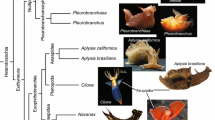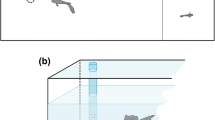Summary
-
1.
The interaction between two discrete behavioral acts, feeding and withdrawal from tactile stimulation, was examined in 32 specimens of the marine molluskPleurobranchaea. The experimental paradigm (Fig. 2) incorporated gradation of the intensity of the respective sensory stimuli for both behaviors over a wide range.
-
2.
Withdrawal amplitude was suppressed during simultaneous feeding in individual animals (Figs. 5 and 7) and in grouped data from all 32 subjects (Fig. 9). The suppression of withdrawal was greater with increased feeding intensity (Fig. 9).
-
3.
Feeding intensity declined during simultaneous withdrawal in individual animals (Figs. 6 and 8) and in grouped data from all subjects (Fig. 10). The suppression of feeding during withdrawal was greater with increased withdrawal intensity, and less with increased feeding intensity (Fig. 10).
-
4.
It is concluded that feeding and withdrawal interact reciprocally rather than hierarchically, and a modified scheme for the overall organization ofPleurobranchaea's behavioral hierarchy is presented (Fig. 11). The findings are discussed from an evolutionary, ethological and neurophysiological view point.
Similar content being viewed by others
References
Audesirk, G., Audesirk, T.: Complex receptor neurons inTritonia: Neural correlates of a change in behavioral responsiveness. Society for Neurosciences Abstracts5, 240 (1979)
Barnwell, G.M., Stafford, F.S.: A mathematical model of decisionmaking neural circuits controlling behavioral mode selection. Bull. Math. Biol.39, 223–237 (1977)
Beeman, R.W.: The anatomy and functional morphology of the reproductive system in the Opisthobranch molluskPhyllaplysia taylori Dall, 1900. Veliger13, 1–31 (1970)
Camhi, J.M.: Behavioral switching in cockroaches: Transformations of tactile reflexes during righting behavior, J. Comp. Physiol.113, 283–301 (1977)
Davis, W.J., Mpitsos, G.J.: Behavioral choice and habituation in the marine mollusk,Pleurobranchaea californica MacFarland (Gastropoda, Opisthobranchia). Z. Vergl. Physiol.75, 207–232 (1971)
Davis, W.J., Mpitsos, G.J., Pinneo, J.M.: The behavioral hierarchy of the molluskPleurobranchaea. I. The dominant position of the feeding behavior. J. Comp. Physiol.90, 107–224 (1974a)
Davis, W.J., Mpitsos, G.J., Pinneo, J.M.: The behavioral hierarchy of the molluskPleurobranchaea. II. Hormonal suppression of feeding associated with egg-laying. J. Comp. Physiol.90, 225–243 (1974b)
Davis, W.J., Mpitsos, G.J., Pinneo, J.M., Ram, J.L.: Modification of the behavioral hierarchy ofPleurobranchaea. I. Satiation and feeding motivation. J. Comp. Physiol.117, 99–125 (1977)
Fentress, J.C.: Specific and nonspecific factors in the causation of behavior. In: Perspectives in ethology. Bateson, P.P.G., Klopfer, P.H. (eds.), pp. 155–224. New York: Plenum 1973
Fentress, J.C.: Dynamic boundaries of patterned behavior: interaction and self organization. In: Growing points in ethology. Bateson, P.P.G., Hinde, R.A. (eds.), pp. 135–169. Cambridge: Cambridge University Press 1976
Hinde, R.A.: Animal behavior: A synthesis of ethology and comparative psychology, 2nd edn. New York: McGraw-Hill 1970
Lersel, J.J.A., Bol, A.C.A.: Preening of two tern species. A study on displacement activities. Behaviour13, 1–88 (1958)
Kovac, M.P., Davis, W. J.: Behavioral choice: neural mechanisms inPleurobranchaea. Science198, 632–634 (1977)
Kovac, M.P., Davis, W.J.: Neural mechanism underlying behavioral choice inPleurobranchaea. J. Neurophysiol.43, 469–487 (1980)
LeBoeuf, B.J.: Sexual behavior in the northern elephant sealMirounga angustirostris. Behaviour41, 1–26 (1972)
Ludlow, A.R.: The behavior of a model animal. Behaviour58, 131–172 (1976)
Mpitsos, G.J., Davis, W.J.: Learning: Classical and avoidance conditioning in the molluskPleurobranchaea. Science180, 317–320 (1973)
Pring-Mill, A.F.: Tolerable feedback: A mechanism for behavioural change. Anim. Behav.27, 226–236 (1979)
Rowell, C.H.F.: Displacement grooming in the chaffinch. Anim. Behav.9, 38–63 (1961)
Rushforth, N.B.: Behavioral modifications in coelenterates. In: Invertebrate learning: protozoans through annelids, Vol. I. Dyal, J.A., Willows, A.O.D. (eds.), pp. 123–169. New York: Plenum 1973
Rushforth, N.B., Krohn, I.J., Brown, L.K.: Behavior inHydra: Inhibition of the contraction response ofHydra piradi. Science145, 602–604 (1964)
Sherrington, Ch.: The integrative action of the nervous system. New Haven, Conn.: Yale University Press 1906
Author information
Authors and Affiliations
Additional information
Supported by NIH Research Grant NS 09050. We thank Terry Brown, Kathy Coffaro, Eugene Matera, Erica Prince, Mark Rigler and Justin Stormo-Gibson for technical assistance in various phases of this work.
Rights and permissions
About this article
Cite this article
Kovac, M.P., Davis, W.J. Reciprocal inhibition between feeding and withdrawal behaviors inPleurobranchaea . J. Comp. Physiol. 139, 77–86 (1980). https://doi.org/10.1007/BF00666197
Accepted:
Issue Date:
DOI: https://doi.org/10.1007/BF00666197




